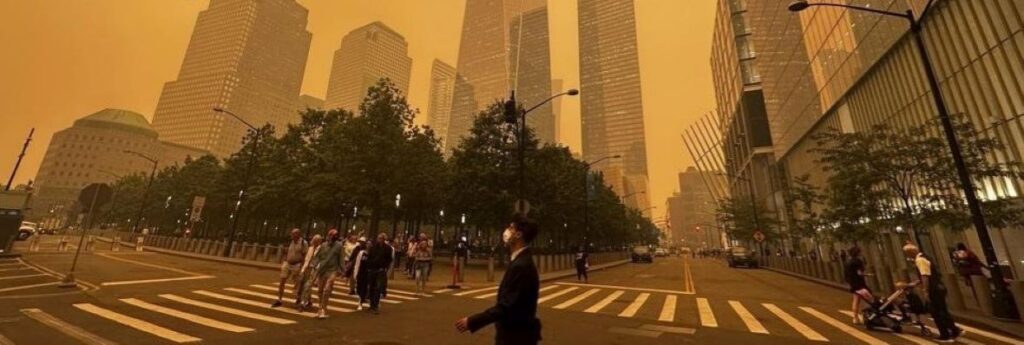On air quality maps, purple signifies the worst of it. In reality, it’s a thick, hazardous haze that’s disrupting daily life, including travel, for millions of people across Canada and the US, blotting out skylines and turning skies orange.
And with weather systems expected to hardly budge, the smoky blanket billowing from wildfires in Quebec and Nova Scotia and sending plumes of fine particulate matter as far away as North Carolina and northern Europe should persist into the weekend.
That means more of the dystopian-style detour that’s chased players from ballfields, actors from Broadway stages, delayed thousands of flights, and sparked a resurgence in mask wearing and remote work — all while raising concerns about the health effects of prolonged exposure to such bad air.
The weather system that’s driving the great Can-Am smoke out – a low-pressure system over Maine and Nova Scotia — “will probably be hanging around at least for the next few days,” U.S. National Weather Service meteorologist Bryan Ramsey said.
“Conditions are likely to remain unhealthy, at least until the wind direction changes or the fires get put out,” Ramsey said. “Since the fires are raging — they’re really large — they’re probably going to continue for weeks. But it’s really just going be all about the wind shift.”
Across the eastern North America, on both sides of the border, officials warned residents to stay inside and limit or avoid outdoor activities again Thursday, extending “Code Red” air quality alerts in some places for a third-straight day as forecasts showed winds continuing to push smoke-filled air south.
The smoke has moved over Greenland and Iceland since June 1, and was expected to reach Norway on Thursday, the Norwegian Climate and Environmental Research Institute said, but wasn’t expected to be a health concern.
Hazy skies tinged with an eery yellow glow greeted millions of Canadians in Quebec and Ontario this week as the smoke continued to cause air quality warnings in Canada’s most populated corridor.
On Wednesday, Environment Canada’s air quality health index listed Ottawa and Gatineau, Que., as the worst in Canada, followed closely by the eastern Ontario cities of Kingston, Cornwall and Belleville.
The smoke was so thick in downtown Ottawa that Gatineau’s high-rise office towers were barely visible just a few hundred metres away across the Ottawa River.
In a bizarre twist of fate, on a day when air quality was among the worst the country has ever seen, it was national Clean Air Day in Canada.
Emergency Preparedness Minister Bill Blair said more than 400 fires were burning across the country – 163 in Quebec alone – and more than half of them were still out of control.
The amount of land burned surpassed the 40,000-sq.kn. mark, making 2023 Canada’s fourth-worst fire season on record before the summer has even officially begun. At the current pace of burning, the all-time record will be surpassed by next week.
“By all measures, this is perhaps the worst year we have experienced with wildfires,” Blair said.
Although the majority of the fires are burning in northern and western Quebec, the smoke is affecting much of the Montreal-Windsor corridor, and is causing air quality warnings as far south as Washington, D.C.
Eastern Quebec got some rain Wednesday, but Montreal-based Environment Canada meteorologist Simon Legault said no significant rain is expected for days in the remote areas of central Quebec where the wildfires are more intense.
In the US, federal officials paused some flights bound Wednesday for New York’s LaGuardia Airport and slowed planes to Newark and Philadelphia because smoke was limiting visibility.
In New York City, a dense, orange-tinted fog settled among the skyscrapers of Manhattan, forcing athletes and older Americans alike to take shelter indoors. Schools across the region cancelled outdoor activities.
In low-visibility areas, motorists were urged to stay off the roads, while the Federal Aviation Administration ordered temporary ground stops at major airports in New York and Philadelphia.
Air passengers reported smelling smoke inside the plane as their flights descended into the haze. New York Mayor Eric Adams urged citizens to remain indoors. And residents of the West Coast and the Pacific Northwest, where wildfire smoke is a regular part of life, urged their eastern counterparts to get a grip
The sky was “yellow and grey,” said Michael Gerrard, director of the Sabin Center for Climate Change Law at New York’s Columbia Law School, who spent the day working from his suburban home in Westchester, north of the city. “The last time I smelled air like that, I was in New Delhi.”
The Indian capital is typically top of the list when it comes to the world’s worst air quality, but on Wednesday it was overtaken by the Big Apple.
On Twitter, which was awash in photos and videos of the otherworldly scene, the National Weather Service posted a time-lapse video that showed the New York skyline gradually disappearing behind a thick orange veil. Some tourists persisted in ascending to the top of the Empire State building, though there wasn’t much to see.
Major League Baseball’s Yankees and Phillies had their games postponed, while on Broadway, “Hamilton” and “Camelot” cancelled performances and “Prima Facie” star Jodie Comer left a matinee after 10 minutes because of difficulty breathing. The show restarted with an understudy, show publicists said.
It was not to be at Central Park’s outdoor stage, either. Shakespeare in the Park cancelled its Thursday and Friday performances of “Hamlet,” saying ’tis not nobler in the mind to suffer the slings and arrows of wretched air.

